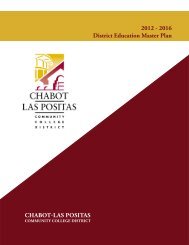City College of San Francisco - California Competes
City College of San Francisco - California Competes
City College of San Francisco - California Competes
You also want an ePaper? Increase the reach of your titles
YUMPU automatically turns print PDFs into web optimized ePapers that Google loves.
STANDARD III.D<br />
The <strong>College</strong>’s annual budget development<br />
process begins with an assessment <strong>of</strong> the<br />
expected resources for the new fiscal year. This<br />
assessment is done in collaboration with the<br />
Chancellor and the Vice Chancellor for<br />
Academic Affairs/Student Development and<br />
the <strong>College</strong>’s Vice Chancellor for Finance and<br />
Administration, Chief Financial Officer, and<br />
Director <strong>of</strong> Budget and Accounting. Information<br />
is gathered from a variety <strong>of</strong> sources including<br />
the State Chancellor’s Office, the <strong>College</strong>’s representative<br />
in Sacramento, legislative staff, and,<br />
for local revenues, the <strong>City</strong> Controller’s Office.<br />
This information is then incorporated into an<br />
overall resource projection and presented to the<br />
<strong>College</strong>’s PBC as a parameter for the budget for<br />
the new fiscal year. [Ref. 6]<br />
As detailed in the annual set <strong>of</strong> budget instructions,<br />
each cost center manager’s budget request<br />
is submitted to the respective Vice Chancellor<br />
for review. [Ref. 7] After the Vice Chancellor<br />
concurs that the cost center budgets are a realistic<br />
plan for continuing ongoing operations,<br />
the budgets are forwarded to the members <strong>of</strong><br />
the PBC. The documents PBC members review<br />
directly connect budget requests with specific<br />
strategic goals and objectives. The PBC then<br />
ensures that available resources are squarely<br />
framed around the <strong>College</strong>’s efforts to support<br />
student learning outcomes and the overall needs<br />
<strong>of</strong> the local community. As a further check on<br />
this process, the Chief Financial Officer runs<br />
multiple iterations <strong>of</strong> the operating budget using<br />
Banner to certify that the <strong>College</strong>’s budget will<br />
be balanced. When the Board <strong>of</strong> Trustees votes<br />
on the final budget, it authorizes multiple levels<br />
<strong>of</strong> spending contingent on final state budget<br />
allocations. [Ref. 8]<br />
In September 2005, the Board <strong>of</strong> Trustees<br />
approved the Chancellor’s recommendation<br />
to establish a Division <strong>of</strong> Institutional<br />
Advancement led by a Vice Chancellor. This<br />
is a major step to bolster the <strong>College</strong>’s efforts<br />
to expand its resource base. The new division<br />
will integrate the <strong>College</strong>’s Office <strong>of</strong> Research,<br />
Planning and Grants with the Office <strong>of</strong> <strong>College</strong><br />
Development as well as the CCSF Foundation<br />
guided by the <strong>College</strong>’s Advancement Plan.<br />
The <strong>College</strong>’s Advancement Plan maps out a<br />
strategy for helping to “fill-in the gaps” and<br />
provide funding for those items that go beyond<br />
basic operations. [Ref. 9] For example, priority<br />
areas for increased funding in the Advancement<br />
Plan include basic skills, workforce training,<br />
access to student services, and improved technology<br />
for classrooms. In addition, both the<br />
<strong>College</strong>’s Office <strong>of</strong> Research, Planning and<br />
Grants, as well as its Workforce Development<br />
Office, have been highly successful in attracting<br />
new sources <strong>of</strong> funding through the competitive<br />
grants process. The <strong>College</strong> currently receives<br />
more than $20 million per year in this area.<br />
Examples <strong>of</strong> this include $8,414,306 received<br />
from the National Science Foundation for various<br />
Biotechnology training programs (including<br />
Bio-Link, the National Advanced Technological<br />
Education Center for Biotechnology Education)<br />
and grants totaling $403,000 from the Koret<br />
Foundation for basic skills programs. [Ref. 1]<br />
Furthermore, the Chancellor has successfully<br />
forged new partnerships with groups such as the<br />
<strong>San</strong> <strong>Francisco</strong> Chamber <strong>of</strong> Commerce and <strong>San</strong><br />
<strong>Francisco</strong> State University, thereby increasing the<br />
<strong>College</strong>’s ability to leverage resources in the<br />
grants arena.<br />
III.D.1.c. When making short-range financial<br />
plans, the institution considers its long-range<br />
financial priorities to assure financial stability.<br />
The institution clearly identifies and plans for<br />
payment <strong>of</strong> liabilities and future obligations.<br />
The <strong>College</strong>’s Strategic Plan contains eight strategic<br />
priorities, one <strong>of</strong> which is to “identify and<br />
promote strategies to ensure stable funding,”<br />
an essential part <strong>of</strong> the <strong>College</strong>’s fiscal planning<br />
process. [Ref. 5] This process begins with the<br />
review and adoption <strong>of</strong> the Annual Plan, which<br />
includes detailed operational and developmental<br />
objectives. These objectives are used by each<br />
major cost center and its respective departments<br />
to develop annual budget requests for submittal<br />
to the Vice Chancellors. Requests that are supported<br />
at the Vice Chancellor level are then<br />
placed presented in the Management Plan.<br />
[Ref. 6]<br />
210 CITY COLLEGE OF SAN FRANCISCO







